The Razer Edge Review
by Vivek Gowri on March 28, 2013 11:00 AM EST- Posted in
- Tablets
- Mobile
- Razer
- Razer Edge
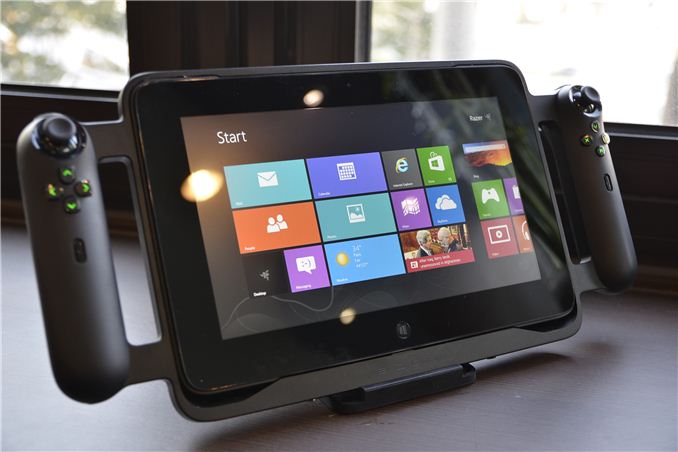
This story starts in a dark meeting room in the back of Razer’s booth at CES 2012. I’m sitting with CEO Min-Liang Tan, who is walking me through the intriguing Project Fiona concept gaming tablet. A number of major manufacturers announced Tegra 3 and OMAP4-based Android slates at CES 2012, but Project Fiona stood out – instead of an ARM SoC, it ran a Core i7 CPU, Nvidia graphics, and Windows 7. At the time my guess was an i7-2617M ultra-low voltage processor and an Nvidia GT 520M, though I never got a confirmation on either spec from Razer. In addition to the powerhouse specs, the tablet had handles resembling two Wii nunchucks attached to either side. Even with a small 10.1” display, the performance-oriented silicon and gamepad combined for a tablet that was big, hot, and heavy. Clearly, not an ideal solution, but the concept had obvious potential and was almost a lock to reach production eventually. It walked away from Las Vegas with a handful of awards.
Eventually turned out to be today, and so we have the Razer Edge. It’s the final production version of Project Fiona and comes with a few very key refinements, including updated silicon and a removable gamepad controller. There are really two angles to cover with the Edge. One is that it’s far and away the most powerful tablet on the market, the other is that there are a full complement of accessories that can transform it into a portable gaming machine, a console, a desktop, or (eventually) a notebook PC. With the range of add-ons available, the Edge turns out to be a pretty versatile system that can fit a number of usage models.
Razer tried an interesting tactic with Project Fiona – they turned to their Facebook and Twitter followers late last year to get feedback on what exactly the final product should look like. The choices offered were a thin, light, inexpensive ARM-based Android tablet, a Windows tablet with Ivy Bridge and integrated graphics, Ivy Bridge and a mid-range dGPU, as well as the when-pigs-fly option of a GTX-class graphics card. Based on the responses Razer got back from their crowdsourcing efforts, Min-Liang Tan posted the final spec on his Facebook: “Over 10,000 PC gamers voted to say that it should be feature an Intel Core CPU, mid-range discrete graphics card, up to double the thickness and weight of the new iPad, detachable controls and be priced at US$1200-$1400.”
Considering that the initial design concept shown at CES basically hit those marks (save for the detachable controls) I’d say that the result was unsurprising, but it was a good show from Razer to actively engage the community and listen to their feedback. The Edge was submitted to the FCC almost two weeks before Razer even started asking for feedback on their forthcoming tablet, and was given approval a week before the crowdsourced spec was announced, so it’s unclear how much the responses played into the final product beyond the marketing angle that Razer has been playing up.
From a hardware standpoint, the Edge is a monster. Anytime you start talking Ivy Bridge and dedicated graphics in a 10.1” tablet, the result is going to be slightly unhinged. Razer went with the proven Ivy Bridge ULV/Kepler combination, and for good reason, because it has been an absolute godsend for mobile products. All variants of the Edge come with Nvidia’s GT 640M LE graphics card, which serves as the major silicon-level differentiator between the Edge and other IVB-based tablets like Microsoft’s Surface Pro and Samsung’s ATIV Smart PC Pro 700T. The GT 640M LE is the lowest end of the Kepler totem pole, with Optimus, 384 cores, 16 ROPs, 32 TMUs, and core clocks of 500MHz with GPU boost pushing that to 570MHz. In this guise, there’s 2GB of DDR3 VRAM clocked at the reference 900MHz with a 128-bit memory interface. Interestingly enough, this is the same graphics core as the 2nd-gen Blade, except with lower clock speeds and far slower memory.
The power draw question is an important one – the ultra-low voltage IVB parts have a 17W TDP, while the GT 640M LE has a TDP in the 20W range (between the various speed and memory configurations, it’s hard to be exact). Toss in additional loads from the display, SSD, RAM, WiFi, and then we’re talking real numbers. It’s hard to find workloads that peg both CPU and GPU, so expecting a 40W draw during typical gaming situations wouldn’t be unreasonable. That’s a *lot* for a handheld device. And so, naturally, the Edge is quite a bit thicker than other tablets at 19.5mm (0.8”) – compare that to Surface Pro at 13.5mm, or to jump into the ARM tablet realm, the iPad at 9.4mm and the Nexus 10 at 8.9mm. Hell, the Edge is thicker than my Zenbook Prime when closed (18mm at its thickest point).
It simply needs to be that thick to dissipate heat effectively – 40W thermal loads are no joke. But it’s not just thick in the z-direction, the footprint is also pretty large considering that the screen is only 10.1” diagonally. The x and y-dimensions are actually a bit larger than the Surface Pro (which has a 10.6” display) and far beyond normal 10.1” tablets, though they are still well short of the 11.6” tablets out there. The Edge is unsurprisingly heavy by tablet standards, but matches Surface Pro at 2 pounds even with a larger chassis and significantly more computing horsepower on board.
Other specs include Intel’s Centrino-N 2230 wireless card (2.4GHz only, no dual-band 5GHz fanciness here even though it really should be mandatory for anything costing more than $500), a 10.1” 1366x768 IPS display sourced from LG, a Synaptics capacitive touchscreen, and a 41.44Wh Li-poly battery. A note about the display – while most of the other Ivy Bridge-based slates and convertible tablets playing in this price range feature 1080p panels, I’m actually alright with the Edge having a low-res panel because GT 640M LE will absolutely choke at anything higher than 768p. Given the additional constraints on power consumption and thermal dissipation, it was likely just easier (and cheaper) to ship a 1366x768 panel.
As far as on-tablet port selection goes, there’s a USB 3.0 port, a combo 3.5mm jack, and the dock/power connector. That’s it. When you consider that Surface Pro has a mini DisplayPort video connector as well as an SD card slot in addition to USB 3.0 port in a slimmer chassis, it’s truly disappointing to see that there are basically no ports beyond the lone USB. I understand that when mobile, it’s rare to need more than one USB port, but the lack of on-device video out is a pretty crucial oversight. At present, the only way to get video out from the Edge is to buy the HDMI docking station. There simply needs to be an easier way to do it without resorting to bringing the dock everywhere you go, even if it means an adapter from mini to full size HDMI. I’d actually even be okay with a dock connector to video out adapter, the way Apple does it.
In an interesting side note, Razer is also announcing a partnership today with Valve to preinstall Steam on the shipping Edge units. It’ll likely be one of the first pieces of software installed on the Edge (it certainly was for me), so it’s a move that makes sense for both companies, especially since Razer is marketing the Edge as a portable open console.
The Edge comes in two flavors, base and Pro. The entry-level SKU has an i5-3317U (1.7GHz), 4GB of DDR3, and a 64GB SSD for $999, while the Edge Pro bumps that up to an i7-3517U (1.9GHz), 8GB, and a 128GB SSD for $1299. Upgrading to a 256GB drive costs a further $150. The evaluation unit we received was the full-tilt Edge Pro 256GB, which has an SF-2200-based ADATA XM14 mSATA SSD. The pricing makes sense, with the base Edge coming in at a $100 premium over an equivalent 64GB Surface Pro. You lose the 1080p display and Wacom digitizer, but the graphics card makes for a pretty potent trump card.
With that said, I’d certainly hesitate to get the base model with just 64GB of storage; after taking out the chunks for recovery partitions and Windows, you might have half that space remaining. Considering the size of games these days, it’s not really a workable solution. I’ve installed maybe 10 games on my Edge review unit (the seven in our 2012 benchmark suite, plus a couple more) and there’s only 90GB of free disk space left. The 128GB Pro seems to be the sweet spot in the Edge lineup, particularly when bundled with the gamepad controller for $1499.
That brings us to the other side of the story: the range of accessories Razer is releasing alongside the Edge. The most prominent among them, of course, is the gamepad controller, as well as a docking station that provides an HDMI and three USB ports. Both are available now alongside the tablet, while the third piece of the accessory puzzle, a mobile keyboard dock, will not show up until Q3. In typical Razer fashion, the accessory costs are borderline highway robbery - the gamepad controller retails at $249, the HDMI dock goes for $99 and the laptop dock will end up at least $150 when it does release eventually. That doesn’t even factor in the $69 for the secondary 41.44Wh battery that slots into the gamepad and laptop dock. It all adds up, and eventually the reasonable cost of the tablet hardware starts to look not so reasonable anymore. But we’ll get there.


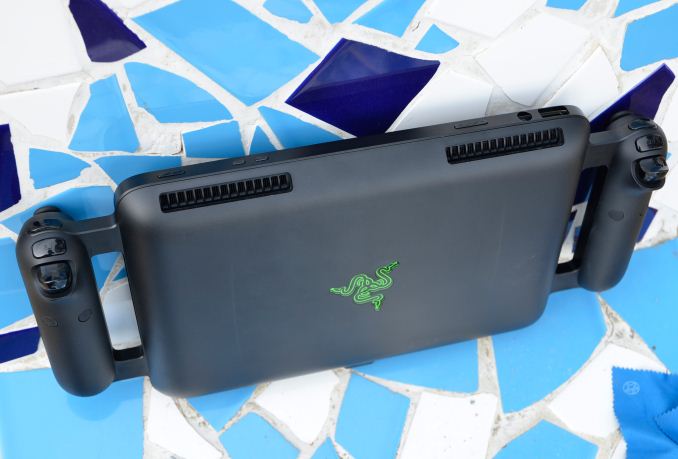

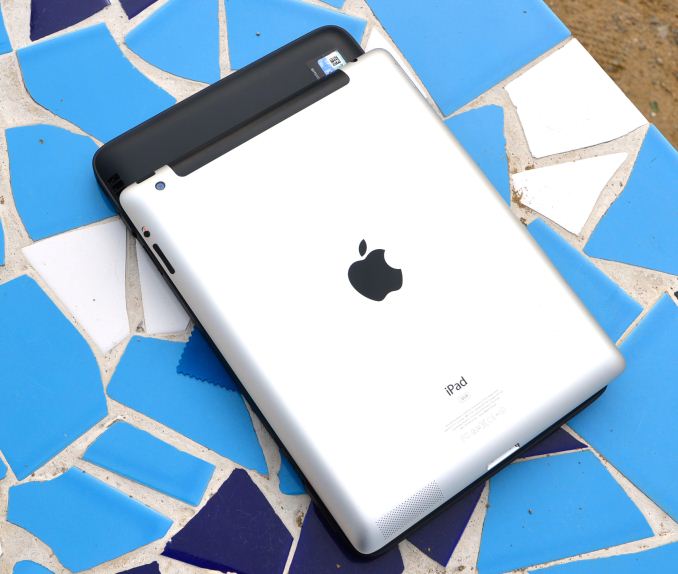
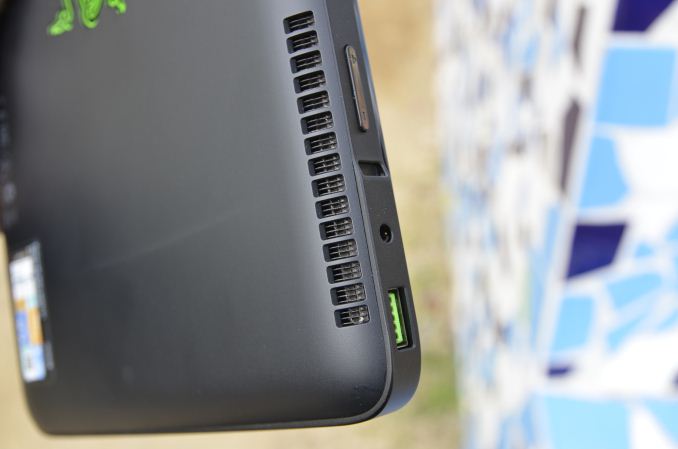
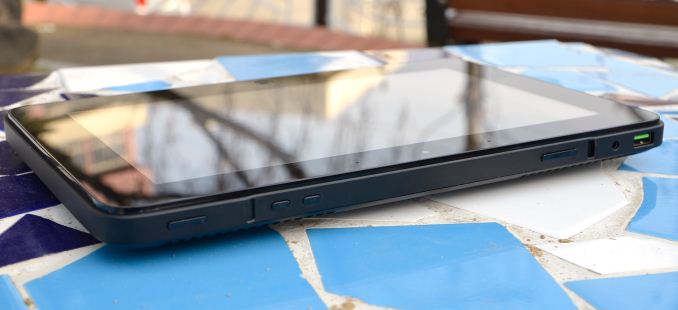
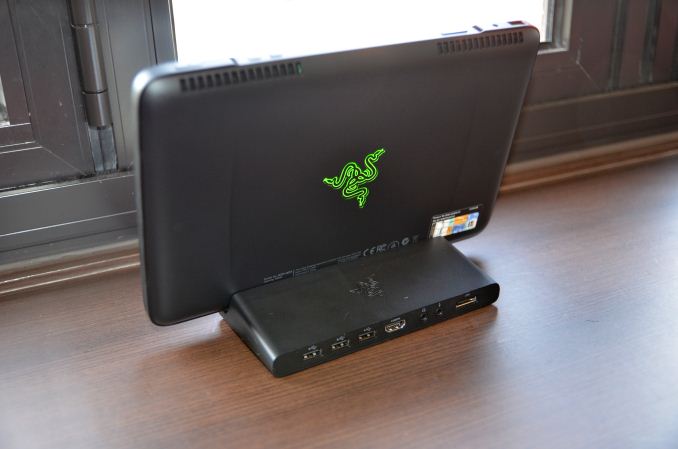














89 Comments
View All Comments
VivekGowri - Friday, March 29, 2013 - link
All of the battery life tests (in the graphs) were done with the internal 41Wh battery, with the tablet alone - not attached to the gamepad or the docking station. 5 hours of light web-usage is for the tablet alone, no extended batteries involved.The gaming tests were the only ones done with the extended battery and gamepad controller (which I think have to be bought together for the package to make any sense). I do wish that the gamepad came with the extended battery by default, Razer is definitely charging too much for the accessories.
TrackSmart - Friday, March 29, 2013 - link
I think the review does a fine job of giving us a sense of the product. The one change I would make is to emphasize the battery issue in the Conclusions in a more concrete way:For example: "You can only expect around 1 hour of gaming time using the built-in 41 Wh battery and just over 2 hours with the gaming dock plus extra battery pack ($XXX extra). For a system that promises PC-quality gaming on the road, this may be a fatal flaw."
That's the point that really needs to be driven home. This is an impressive system, but the components available today do not have the power efficiency needed to make a truly portable system at this level of performance.
apertotes - Thursday, March 28, 2013 - link
Yeah, the second generation is going to be awesome... whatever. I will wait until that awesome product. And I guess many people will do the same. You can not pretend to sell a hardware product on the assumption that the next one is going to be great. This Razer Edge lacks in graphic power and battery life. This one. The one that is now for sale. That sucks.nerd1 - Thursday, March 28, 2013 - link
All razor so-called gaming PCs are big joke, I wonder what they are thinking. I'd rather get a clevo 11.6" with 650M on this.VivekGowri - Thursday, March 28, 2013 - link
I had that system, and I loved the hell out of it. GT 650M is overkill for the 1366x768 panel, FWIW. But the Edge is truly, completely different. It's just a different system in almost every way, there's no real comparison between the two other than on a benchmark sheet.nerd1 - Thursday, March 28, 2013 - link
So I just cannot understand why they chose a tablet form factor. W8 doesn't have many games with touch control (I hate touch control for gaming BTW) so you need keyboard and (good) mouse anyway. And it is not quite portable and very expensive.VivekGowri - Thursday, March 28, 2013 - link
when one sets out to make a gaming tablet, choosing a tablet form factor would in theory seem logical, no?kyuu - Thursday, March 28, 2013 - link
That's what the shell with the gamepad controls is for...?A5 - Thursday, March 28, 2013 - link
Just because you don't like something doesn't mean it is pointless.bountygiver - Thursday, March 28, 2013 - link
But hope some games can add touch control where appropriate. (Like civ 5)